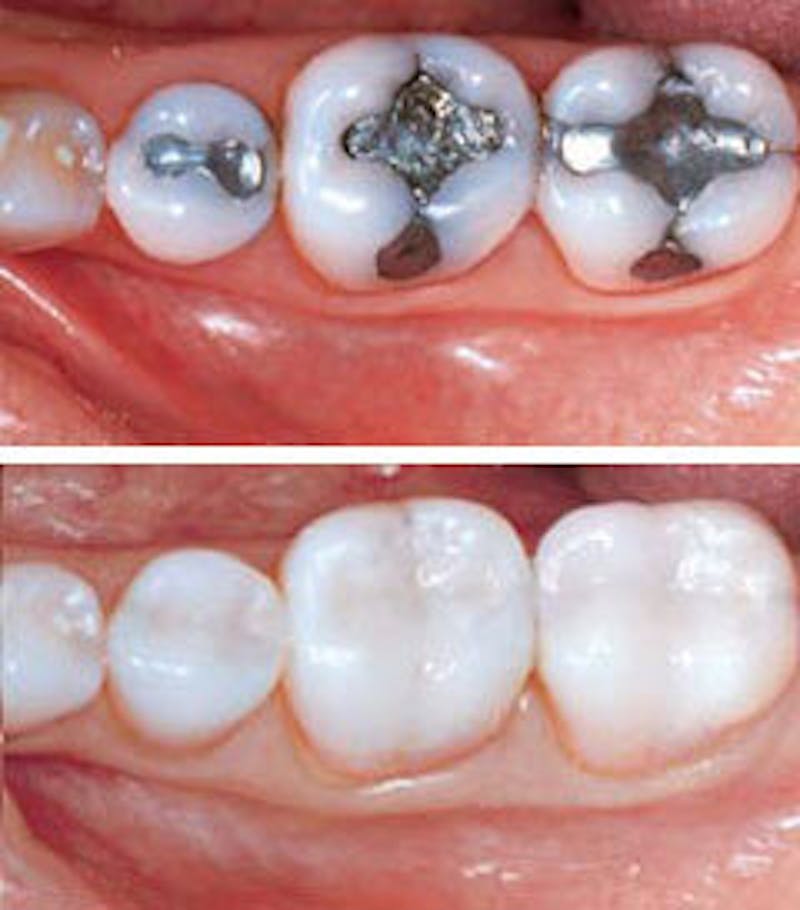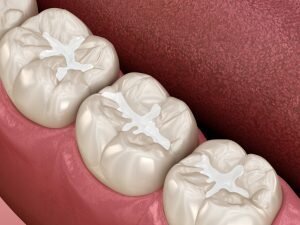
post updated: 12/13/2019
Millions of people have so-called “silver” fillings in their mouths, but is mercury poisoning from fillings a risk? In recent years, the use of mercury in dental amalgam has caused much outcry because of the toxicity associated with mercury as a substance. So are silver fillings safe?
Encouragingly, most scientific research finds little relationship between silver fillings and symptoms of actual mercury poisoning. However, some people choose to replace their mercury fillings with porcelain fillings for cosmetic reasons, because their fillings are no longer effective, because of pain from galvanic shock, or because of legitimate (but rare) allergic reactions.
If you have mercury fillings, are considering having mercury fillings placed for the first time, or need to get your mercury fillings replaced, understanding the benefits and risks of dental amalgam will help you to make an informed choice.
What Are Mercury Fillings Made From?
When we talk about mercury fillings, what we are really talking about are “mercury amalgam” fillings. These dental fillings are made from a combination of metals, called amalgam. The combination of metals used in dental amalgam fillings generally includes mercury, silver, tin, and copper, with mercury making up around half of the mix. Dental amalgam fillings account for around 75% of fillings placed worldwide.
The reason that mercury is used in fillings is that it helps make the mixture pliable. This way, the amalgam can be pressed into the teeth more easily to fill the exact shape of each cavity without the need for a follow-up visit. When the elemental mercury—also known as metallic mercury—is mixed with a powder made from the other metals in the amalgam, the mixture self-seals and hardens. In contrast to gold fillings, dental amalgam fillings only take one visit to place and can last for 10-15 years or more.
Studies On Amalgam and Mercury Poisoning
Studies from all over the world support the idea that the use of mercury-containing dental amalgam is safe for most people. These studies have informed the respective positions of the American Dental Association (ADA) and the Food and Drug Administration (FDA).
The ADA's Position on Mercury Fillings
The ADA states that "scientific evidence supports the position that amalgam is a valuable, viable and safe choice for dental patients". This is supported by a review concluding that "studies continue to support the position that dental amalgam is a safe restorative option for both children and adults.”
The FDA's Position on Mercury Fillings
The position of the Food and Drug Administration (FDA) on the safety of mercury fillings is a little more complex. While its position was initially that "dental amalgam is a commonly used device with a low risk of adverse events reported to the agency" (based on a review of over 200 scientific articles and relevant abstracts), a lawsuit from Charlie Brown and Consumers for Dental Choice (previously Moms Against Mercury) led to significant changes in the FDA’s website.
The Moms Against Mercury Lawsuit
In 2008, Charlie Brown, on behalf of Moms Against Mercury, sued the FDA for its failure to classify (determine the risk of) dental amalgam. By law, every medical device must be classified as per a ruling from Congress in 1976, and the FDA had classified every kind of dental filling material except for dental amalgam fillings.
After the judge ruled in favor of Charlie Brown and said that the FDA must classify mercury fillings, Brown and the FDA Associate Commissioner Randall Lutter negotiated the FDA's website line by line, leading to the FDA issuing this warning:
"Dental amalgams contain mercury, which may have neurotoxic effects on the nervous systems of developing children and fetuses."
Today, in the section on potential risks of dental amalgam, the FDA's website states that "exposure to mercury may pose a greater health risk in the groups…who may be more susceptible to potential adverse effects generally associated with mercury."
These groups include:
-
Pregnant women and their developing fetuses
-
Women who intend to become pregnant
-
Nursing women
-
Infants and children, especially those under six years of age
-
People with neurological disease
-
People with kidney problems
-
People who are sensitive or allergic to mercury, silver, copper, or tin
Finally, the section concludes with a warning that anyone who is allergic or sensitive to any of the metals contained in dental amalgam should not get dental amalgam fillings.
What Studies Reveal About Mercury Poisoning and Allergies from Fillings
The research on mercury poisoning from fillings isn't entirely conclusive. It is known (and stated on the FDA's website) that dental amalgam "releases low levels of mercury in the form of a vapor that can be inhaled and absorbed by the lungs."
However, the question is whether the levels of mercury vapor inhaled on a daily basis are high enough to cause toxicity and adverse health effects, most frequently seen as neurological and kidney damage. If you’re interested in exploring the evidence, you’ll find no shortage of information from both sides with just a little searching.
Studies That Indicate Little to No Risk
Most reviews on the "mercury fillings are safe" side of the debate cite studies that measure vapor, urine, and/or blood mercury levels to determine whether mercury poisoning from fillings is likely. For instance, the studies used in the FDA's literature review (linked above) indicate that:
-
The amount of mercury vapor inhaled isn't high enough to be likely to produce adverse health effects.
-
Urinary mercury levels in individuals with amalgam fillings are much lower than those in workers with kidney injury from mercury poisoning.
-
Brain levels of mercury seen in autopsies did not correlate with the number of amalgams or the instance of Alzheimer's disease.
-
While the concentration of mercury in the kidney is associated with the number of dental amalgams, prospective trials in children over six did not show most of the markers of kidney injury when the children were followed for 5 or 7 years.
Studies That Suggest Adverse Health Effects
On the other side of the debate, a detailed review of the report given to the EU Commission by the Scientific Committee on Emerging and Newly Identified Health Risks (SCENIHR) was published in the Journal of Occupational Medicine and Toxicology in 2011 by author Joachim Mutter. In this review, Mutter refutes the safety claims of the SCENIHR report, arguing that mercury exposure from dental amalgam does, in fact, have detrimental health effects.
In the review, the author:
-
Cites autopsy studies that show that people with dental amalgam have 2-12 times more mercury in their body tissues than those without mercury fillings
-
Observes that "many of the individuals studied had toxic levels of mercury in their brains or kidneys"
-
Cites studies that show a higher mercury burden in babies, children, and the elderly after exposure to dental amalgam
-
Cites evidence that mercury exposure affects female dental assistants' fertility
After summarizing the burden of mercury accumulation in humans, the author writes about the environmental effects of mercury, arguing that, when the environmental costs of mercury from amalgam fillings are taken into account, "amalgam is the most costly dental material."
Comparing Mercury from Fillings to Other Sources of Mercury Poisoning
The kind of mercury used in dental fillings—elemental mercury—is not the same as the mercury found in fish, which is methylmercury (a form of organic mercury). The body processes these two types of mercury differently and has different thresholds for poisoning from each.
However, as the FDA website states, inorganic mercury and organic mercury can transform into each other in the body. This makes it hard to identify the specific effects of either one or the other on the human body. To be safe, it’s best to consume fish and seafood products that are low in mercury if you’re worried about mercury poisoning from any source.
Allergic Reactions
While the debate continues about the potential adverse health effects of mercury fillings over time, no one denies that some people are sensitive and/or have allergic reactions to the metals used in dental amalgam.
A literature review published in 2015 in the Journal of Clinical & Diagnostic Research lists symptoms of sensitivity to mercury and nickel. If you experience any of these symptoms, replacing your mercury fillings with porcelain fillings may resolve the issue:
-
Mercury sensitivity: lesions on the oral mucosa and skin of the neck and face (most commonly oral lichenoid lesions) and burning mouth syndrome
-
Nickel sensitivity: a burning sensation, gingival hyperplasia, and a feeling of numbness on the sides of the tongue
The article doesn’t list symptoms of allergies to any other metals used in amalgam restorations. However, if you experience a burning sensation or skin lesions near your fillings, a metal sensitivity could be the cause.
Galvanic Shock
Finally, mercury fillings could cause a galvanic shock if they touch other gold fillings in your mouth with saliva acting as a conductor.
If you experience pain in or near teeth with gold and silver fillings and don't otherwise have oral lesions or irritation, the discomfort may be the result of galvanic shock in rare cases.
When to See a Dentist
If you have silver fillings that are causing discomfort in any way, it is a good idea to have them checked out by your dental provider to see if they are in good shape or require replacement.
In many cases, it may be safest to leave your amalgam fillings in. However, if you have a metal allergy, you’re experiencing galvanic shock, or your current amalgam fillings need replacing, replacing your “silver fillings” with a different kind of filling could be the best solution.
Replacing Old Silver Fillings

Due to a fear of mercury toxicity and from older fillings wearing down over time, many people have started having their silver fillings replaced with new tooth-colored composite fillings or porcelain fillings. And if stronger, unequivocal proof comes out in the future that the mercury in silver fillings causes health damage, there will likely be a lot more people opting to have them removed.
For maximum longevity, porcelain inlays and onlays are an excellent long-term replacement solution for dental amalgam restorations. Not only are porcelain restorations tooth-colored, but they are extremely strong, resistant to staining, and much longer-lasting than alternatives like composite resin.
Deciding Whether to Have Mercury Fillings Replaced
If you decide to have your silver fillings removed, make sure you ask questions to get all the facts and check that the dentist uses an amalgam separator to protect the area. Otherwise, keep an eye on your amalgam fillings for any signs of cracks or breakage and only have them replaced if they are damaged.
The other main reasons to replace mercury fillings with tooth-colored porcelain fillings are:
-
If you want all your teeth to be completely white when you smile
-
If you are experiencing an allergic reaction
-
If you believe a health condition you have might be related to (low-level) mercury poisoning from fillings.
Whatever your specific need or concern, consulting with an experienced cosmetic dentist will help you make an informed decision.
